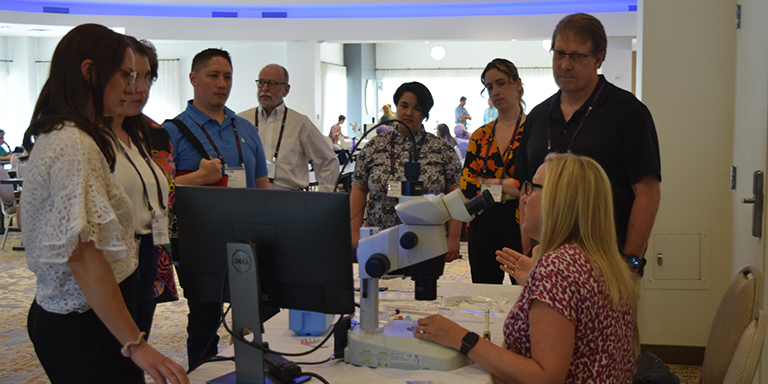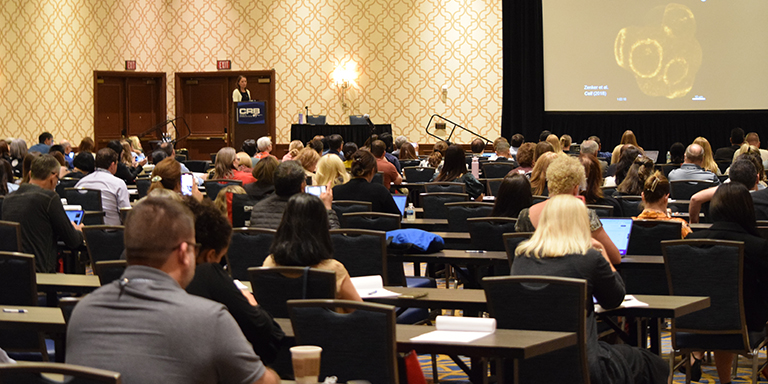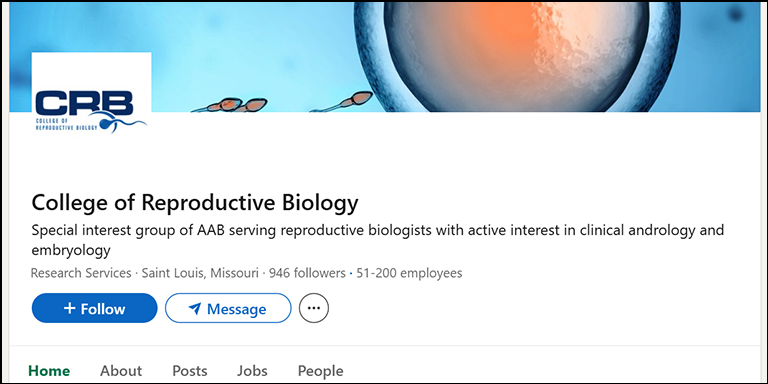
Newsletter
The College of Reproductive Biology (CRB) is a not-for-profit special interest group of the American Association of Bioanalysts (AAB).

Understanding the Warming Procedure for Vitrified Embryos
By Elise Fiskum, BS
Embryo warming is a critical component in the successful application of cryopreservation techniques in ART. Understanding how temperature, osmolarity, and media components interact to restore cellular integrity is important when optimizing protocols, troubleshooting, and improving post-warming outcomes. Currently, vitrification is the most widely used form of gamete cryopreservation in ART. A thorough understanding of the post-vitrification warming procedure can improve this often final step in a patient’s family planning.
A typical warming kit includes three solutions: Thawing Solution (TS), Dilution Solution (DS), and Washing Solution (WS). TS contains extracellular cryoprotectants such as sucrose or trehalose, diluted to form a sticky 1.0 M solution for initial high-temperature warming3, 10, 12, 16, 17.These sugars have a high molecular weight and are too large to cross the cell membrane, with trehalose being the larger and more effective of the two disaccharides7. DS contains the same extracellular cryoprotectants at 0.5 M concentration3, 10, 12, 16, 17. WS primarily contains buffering agents like HEPES to maintain pH stability, mimicking culture media3, 10, 12, 16, 17. In all three solutions, manufacturers may add additional proteins or antibiotics to support embryo re-expansion and minimize contaminates3, 10, 12, 16, 17.
Warming should rapidly bring the embryo to culture temperature (37°C) to avoid ice crystal formation1, 5, 11, 13. Warming at a rate exceeding 2170°C/min is recommended to minimize the time the embryo spends at water’s freezing point, bypassing ice crystal formation during the warming process5, 13. While avoiding ice formation during vitrification is important, warming rate tends to have a greater impact on embryo survival than cooling rate12. A rapid warming rate is necessary for post-vitrification embryo survival.
Though temperature must increase quickly, rehydration of embryos should be gradual during the warming process2, 4. The addition of non-penetrating extracellular cryoprotectants to TS creates a high osmolarity solution, facilitating a moderate osmotic gradient during initial rehydration. Without these additions, water may surge into the embryo too quickly and cause cell membranes to burst with expansion, leading to cell death2, 4, 6. A moderated difference in osmolarity allows diffusion to occur at an optimal rate to minimize damage during re-expansion2, 4.
Subsequent steps of warming occur in DS and WS. These steps are performed at room temperature to minimize solution evaporation, which could affect the solution’s osmolarity and introduce undue stress. Diffusion continues in DS, at a lower osmolarity. Media carry-over is utilized to maintain a gradual gradient, pooling TS around the embryo when moved to DS to slowly allow the embryo to adjust to the 0.5 M solution3. In WS, the same carry-over effect helps the embryo adapt to culture conditions without a rapid decrease in osmolarity3. The name “washing solution” is apt, as this step is also important in minimizing lingering cryoprotectants from freezing. Warming protocols often indicate multiple drops of WS first to allow slow acclimatization to culture conditions, and second to rinse away insulting compounds like DMSO or ethylene glycol. When moving the embryo to a culture drop, minimal freezing compounds that could cause progressive cell death in culture should remain in and around the embryo14.
Embryologists and researchers continue to investigate warming mechanisms to determine the best protocol for embryo warming. Current research indicates that an ultra-fast thaw procedure may improve workflow without compromising embryo integrity, completing the warming process in just one minute using only TS8, 9, 15, 8. Although gradual rehydration has been emphasized in past and current protocols, these new findings highlight the embryo's robust ability to self-regulate. The dramatic increase in osmotic pressure when moving an embryo from TS to culture media seems irrelevant to embryo survival, though sufficient washing through multiple culture drops to remove compounds associated with vitrification remains important. Warming rate and initial rehydration in high-osmolarity TS seem to be the primary factors affecting embryo survival.
References
- A review of best practices of rapid-cooling vitrification for oocytes and embryos: a committee opinion. Fertility and Sterility. 2021 [accessed 2024 Sep 28];115(2):305–310. https://linkinghub.elsevier.com/retrieve/pii/S0015028220326856. doi:10.1016/j.fertnstert.2020.11.017
- Cho H-J. An improved protocol for dilution of cryoprotectants from vitrified human blastocysts. Human Reproduction. 2002 [accessed 2024 Oct 6];17(9):2419–2422. https://academic.oup.com/humrep/article-lookup/doi/10.1093/humrep/17.9.2419. doi:10.1093/humrep/17.9.2419
- Gandhi G, Kuwayama M, Kagalwala S, Pangerkar P. Appendix A: Cryotech® Vitrification Thawing. In: Nagy ZP, Varghese AC, Agarwal A, editors. Cryopreservation of Mammalian Gametes and Embryos. Vol. 1568. New York, NY: Springer New York; 2017 [accessed 2024 Oct 5]. p. 281–295. http://link.springer.com/10.1007/978-1-4939-6828-2_21. doi:10.1007/978-1-4939-6828-2_21
- Isachenko V. Developmental rate and ultrastructure of vitrified human pronuclear oocytes after step-wise versus direct rehydration. Human Reproduction. 2004 [accessed 2024 Oct 6];19(3):660–665. https://academic.oup.com/humrep/article-lookup/doi/10.1093/humrep/deh151. doi:10.1093/humrep/deh151
- Jin B, Kusanagi K, Ueda M, Seki S, Valdez DM, Edashige K, Kasai M. Formation of extracellular and intracellular ice during warming of vitrified mouse morulae and its effect on embryo survival. Cryobiology. 2008 [accessed 2024 Sep 28];56(3):233–240. https://www.sciencedirect.com/science/article/pii/S0011224008000497. doi:10.1016/j.cryobiol.2008.03.004
- Kasai M, Ito K, Edashige K. Morphological appearance of the cryopreserved mouse blastocyst as a tool to identify the type of cryoinjury. Human Reproduction. 2002 [accessed 2024 Oct 6];17(7):1863–1874. https://academic.oup.com/humrep/article-lookup/doi/10.1093/humrep/17.7.1863. doi:10.1093/humrep/17.7.1863
- Lestari SW, Ilato KF, Pratama MIA, Fitriyah NN, Pangestu M, Pratama G. Sucrose ‘Versus’ Trehalose Cryoprotectant Modification in Oocyte Vitrification : A Study of Embryo Development. Biomedical and Pharmacology Journal. 2018 [accessed 2024 Sep 28];11(1):97–104. https://biomedpharmajournal.org/vol11no1/sucrose-versus-trehalose-cryoprotectant-modification-in-oocyte-vitrification-a-study-of-embryo-development/
- Liebermann J, Hrvojevic K, Hirshfeld-Cytron J, Brohammer R, Wagner Y, Susralski A, Jasulaitis S, Chan S, Takhsh E, Uhler M. Fast and furious: pregnancy outcome with one-step rehydration in the warming protocol for human blastocysts. Reproductive BioMedicine Online. 2024 [accessed 2024 Sep 28];48(4):103731. https://www.sciencedirect.com/science/article/pii/S1472648323008301. doi:10.1016/j.rbmo.2023.103731
- Manns J, Patrick JL, Katz I, Holt T, Katz SL, Taylor TH. Clinical Validation of a New, Ultrafast Warming Protocol, Resulting in Equivalent Implantation Rates and Significant Time Savings Versus Routine Warming Protocol, a Prospective Randomized Control. Fertility and Sterility. 2022 [accessed 2024 Sep 28];118(5):e7. https://linkinghub.elsevier.com/retrieve/pii/S001502822201648X. doi:10.1016/j.fertnstert.2022.09.227
- Parmegiani L, Minasi MG, Arnone A, Casciani V, Cognigni GE, Viñoles R, Varricchio MT, Quintero LA, Greco E, Filicori M. “Universal Warming” protocol for vitrified oocytes to streamline cell exchange for transnational donation programs: a multi-center study. Journal of Assisted Reproduction and Genetics. 2020 [accessed 2024 Sep 28];37(6):1379–1385. https://link.springer.com/10.1007/s10815-020-01798-3. doi:10.1007/s10815-020-01798-3
- Rall WF. Factors affecting the survival of mouse embryos cryopreserved by vitrification. Cryobiology. 1987 [accessed 2024 Sep 28];24(5):387–402. https://linkinghub.elsevier.com/retrieve/pii/0011224087900423. doi:10.1016/0011-2240(87)90042-3
- SAGETM Warming Kit – IVF START LABORATORY. [accessed 2024 Sep 28]. https://ivfstart.com/product/sage-warming-kit/
- Seki S, Mazur P. The Dominance of Warming Rate Over Cooling Rate in the Survival of Mouse Oocytes Subjected to a Vitrification Procedure. Cryobiology. 2009 [accessed 2024 Sep 28];59(1):75–82. https://www.ncbi.nlm.nih.gov/pmc/articles/PMC2729265/. doi:10.1016/j.cryobiol.2009.04.012
- Stachecki JJ, Garrisi J, Sabino S, Caetano JP, Wiemer KE, Cohen J. A new safe, simple and successful vitrification method for bovine and human blastocysts. Reproductive BioMedicine Online. 2008 [accessed 2024 Oct 20];17(3):360–367. https://linkinghub.elsevier.com/retrieve/pii/S1472648310602192. doi:10.1016/S1472-6483(10)60219-2
- Taylor TH, Manns JN, Katz I, Patrick JL, Holt T, Katz SE. Ultrafast Warming Protocol Demonstrates Similar Outcomes and Significantly Decreases Embryology Workload Compared to Standard Warming Protocols: A Randomized Control Trial with Euploid Blastocysts. Fertility and Sterility. 2022 [accessed 2024 Sep 28];118(4):e150. https://linkinghub.elsevier.com/retrieve/pii/S0015028222009591. doi:10.1016/j.fertnstert.2022.08.437
- Vit Kit - Warm NX. [accessed 2024 Sep 28]. https://www.irvinesci.com/vit-kit-warm-nx.html
- Vitrification and Thawing Media. Kitazato IVF. [accessed 2024 Sep 28]. https://kitazato-ivf.com/vitrification/vitrification-thawing-media/
CRB News Articles
03/22/2025
Vol. 14, No. 1
03/25/2025
Upcoming CRB Webinar
03/25/2025
Register Now for the 27th Annual CRB Symposium
03/25/2025
CRB Symposium Pre-Conference Workshop
03/25/2025
Navigating Legislative Changes Affecting ART
03/25/2025
The Importance of the 'Hows' and 'Whys' in Assisted Reproduction
03/25/2025
Understanding the Warming Procedure for Vitrified Embryos
03/25/2025
Andrology Antics by Samuel Prien, Ph.D., HCLD(ABB)
03/25/2025
A Special Thanks to the CRB Publication Committee Members
CRB Standing Rules - Log in to view



